Organisational Behaviour: A Study of Structures, Motivation, and Performance Evaluation
VerifiedAdded on 2024/05/17
|18
|4352
|249
AI Summary
This study explores the dynamics of organizational behavior through case studies of Microsoft, Valve, General Mills Canada, Engstrom Auto Mirror, and Morgan Stanley. It examines the reasons for organizational existence, the impact of people on organizational culture, motivation strategies, and performance evaluation methods. The study analyzes the effectiveness of different organizational structures, including the stack ranking system, the Scanlon Plan, and the 360-degree evaluation. It also discusses the challenges and opportunities associated with multitasking, goal setting, and performance appraisal in a global context.
Contribute Materials
Your contribution can guide someone’s learning journey. Share your
documents today.
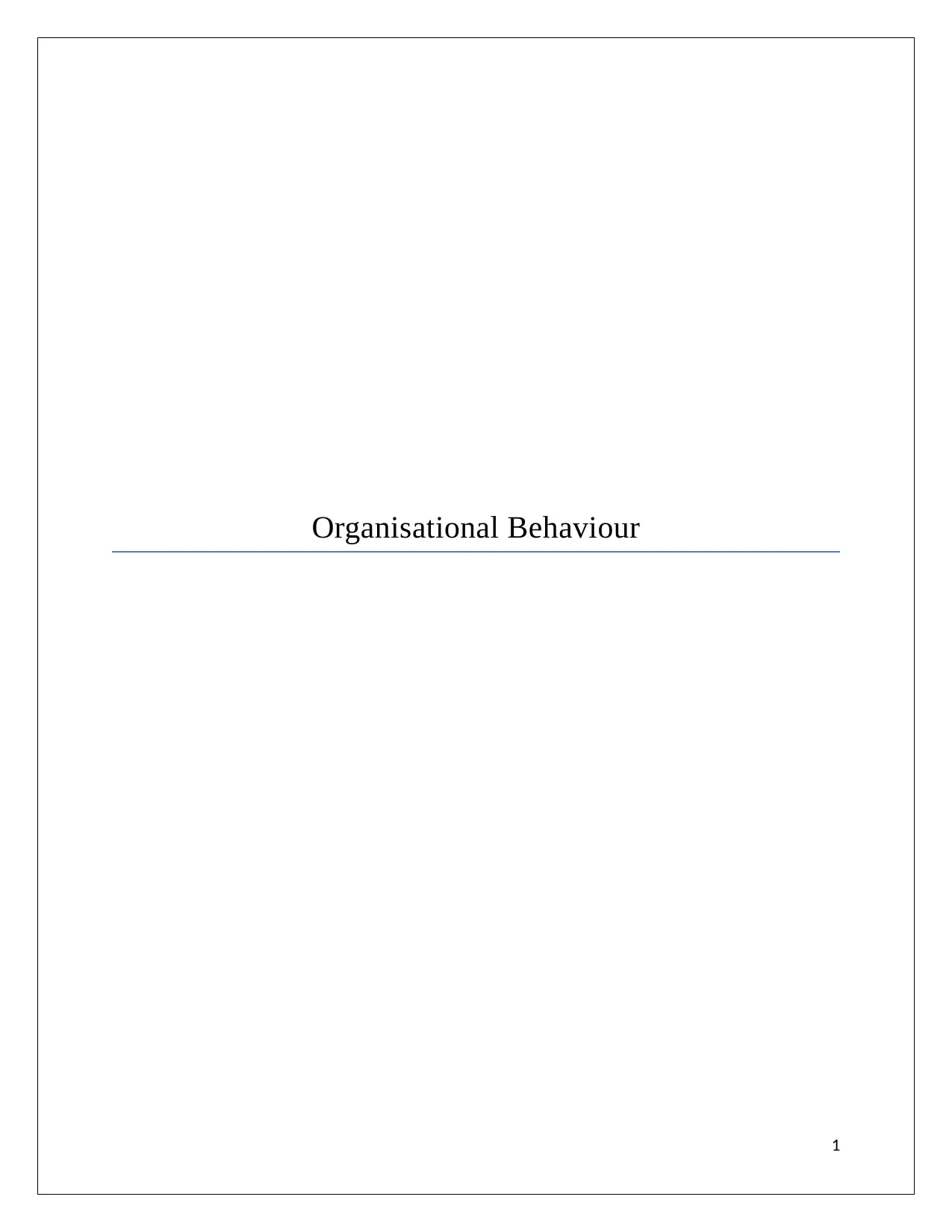
Organisational Behaviour
1
1
Secure Best Marks with AI Grader
Need help grading? Try our AI Grader for instant feedback on your assignments.
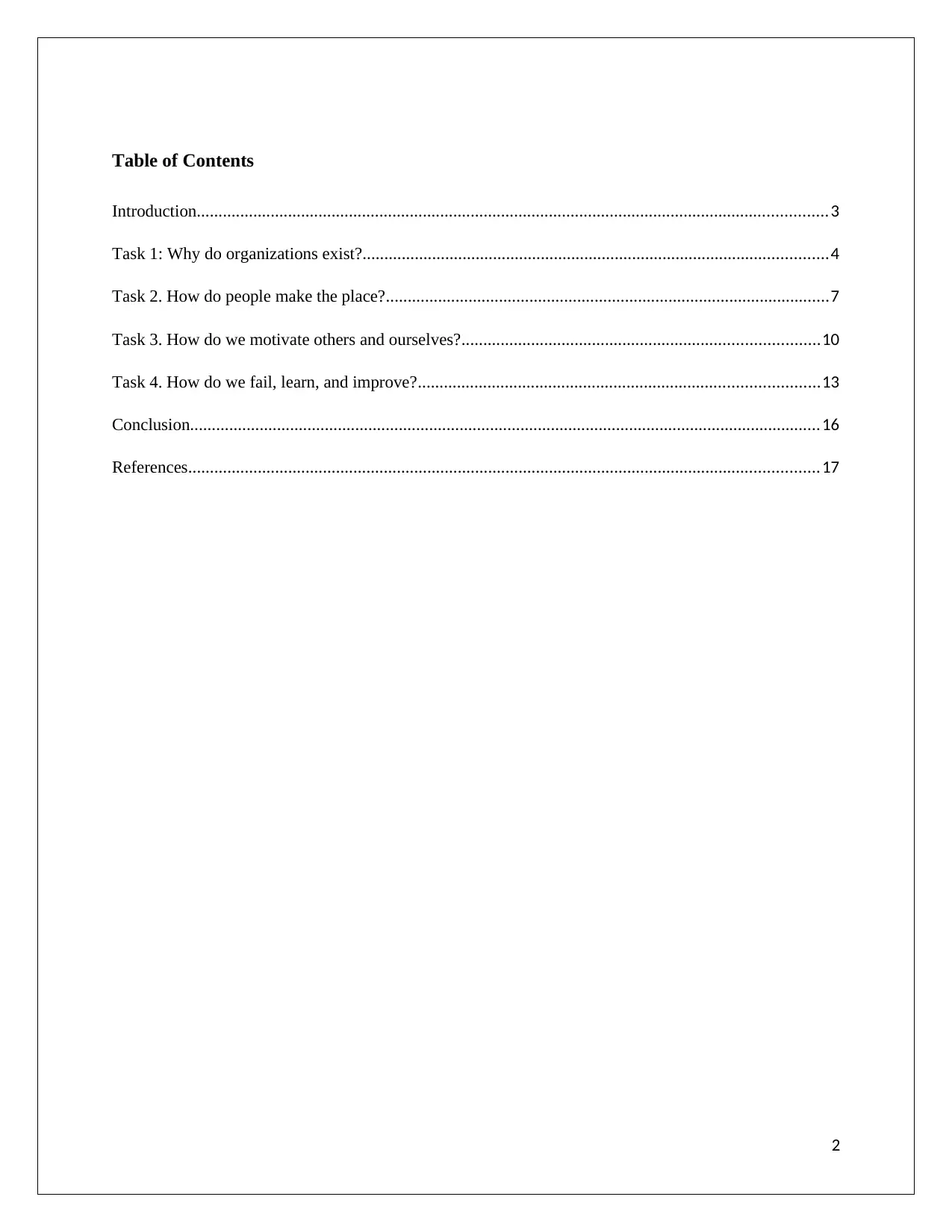
Table of Contents
Introduction.................................................................................................................................................3
Task 1: Why do organizations exist?...........................................................................................................4
Task 2. How do people make the place?......................................................................................................7
Task 3. How do we motivate others and ourselves?..................................................................................10
Task 4. How do we fail, learn, and improve?............................................................................................13
Conclusion.................................................................................................................................................16
References.................................................................................................................................................17
2
Introduction.................................................................................................................................................3
Task 1: Why do organizations exist?...........................................................................................................4
Task 2. How do people make the place?......................................................................................................7
Task 3. How do we motivate others and ourselves?..................................................................................10
Task 4. How do we fail, learn, and improve?............................................................................................13
Conclusion.................................................................................................................................................16
References.................................................................................................................................................17
2
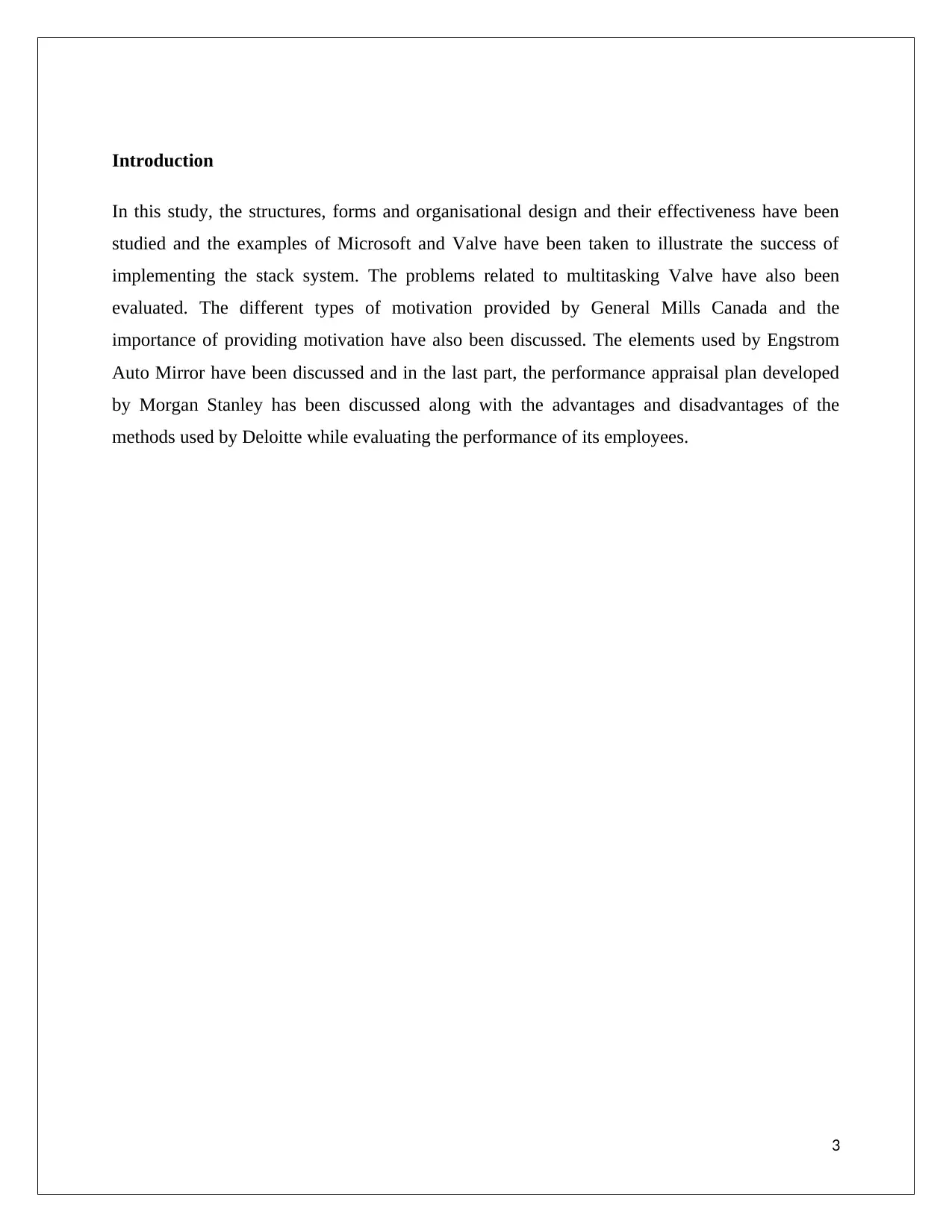
Introduction
In this study, the structures, forms and organisational design and their effectiveness have been
studied and the examples of Microsoft and Valve have been taken to illustrate the success of
implementing the stack system. The problems related to multitasking Valve have also been
evaluated. The different types of motivation provided by General Mills Canada and the
importance of providing motivation have also been discussed. The elements used by Engstrom
Auto Mirror have been discussed and in the last part, the performance appraisal plan developed
by Morgan Stanley has been discussed along with the advantages and disadvantages of the
methods used by Deloitte while evaluating the performance of its employees.
3
In this study, the structures, forms and organisational design and their effectiveness have been
studied and the examples of Microsoft and Valve have been taken to illustrate the success of
implementing the stack system. The problems related to multitasking Valve have also been
evaluated. The different types of motivation provided by General Mills Canada and the
importance of providing motivation have also been discussed. The elements used by Engstrom
Auto Mirror have been discussed and in the last part, the performance appraisal plan developed
by Morgan Stanley has been discussed along with the advantages and disadvantages of the
methods used by Deloitte while evaluating the performance of its employees.
3
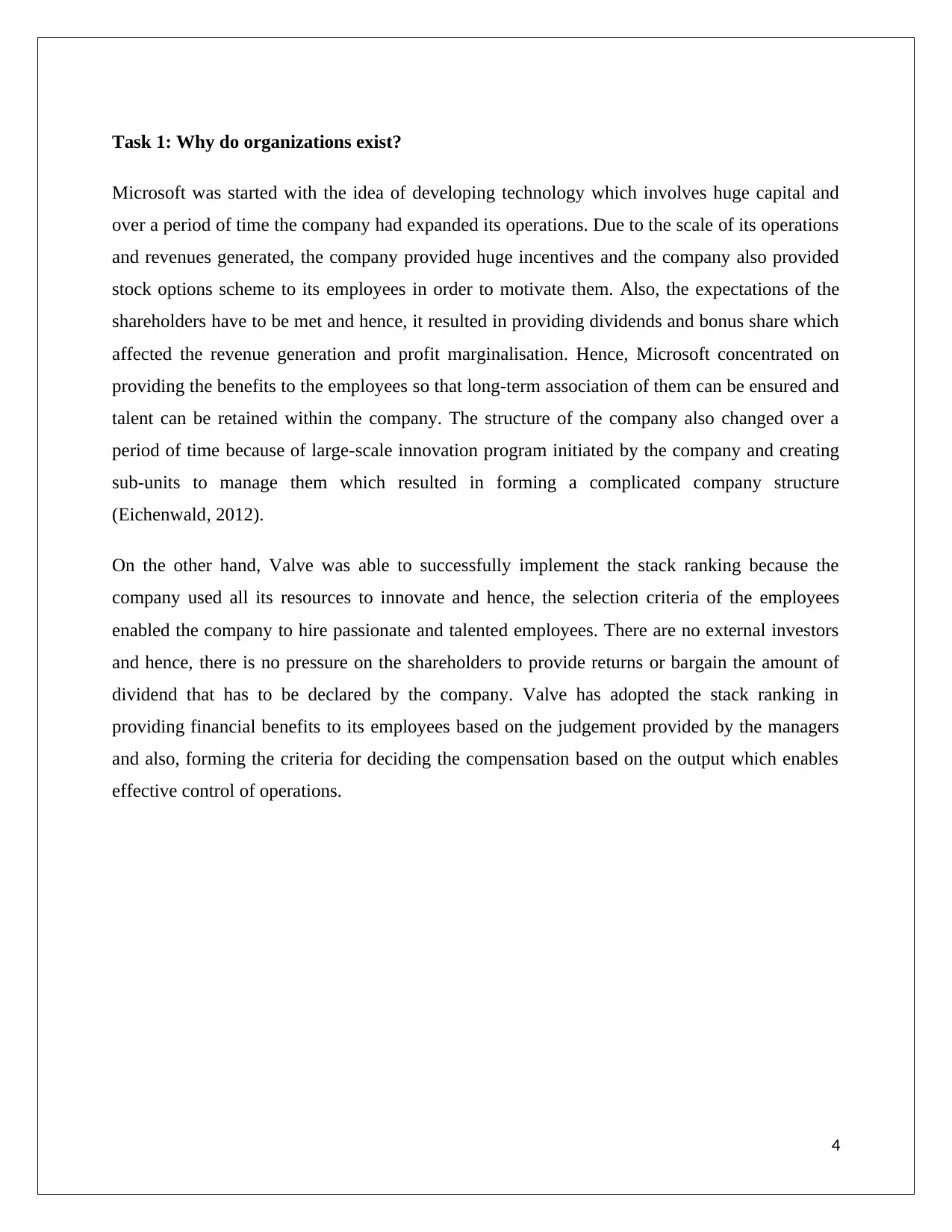
Task 1: Why do organizations exist?
Microsoft was started with the idea of developing technology which involves huge capital and
over a period of time the company had expanded its operations. Due to the scale of its operations
and revenues generated, the company provided huge incentives and the company also provided
stock options scheme to its employees in order to motivate them. Also, the expectations of the
shareholders have to be met and hence, it resulted in providing dividends and bonus share which
affected the revenue generation and profit marginalisation. Hence, Microsoft concentrated on
providing the benefits to the employees so that long-term association of them can be ensured and
talent can be retained within the company. The structure of the company also changed over a
period of time because of large-scale innovation program initiated by the company and creating
sub-units to manage them which resulted in forming a complicated company structure
(Eichenwald, 2012).
On the other hand, Valve was able to successfully implement the stack ranking because the
company used all its resources to innovate and hence, the selection criteria of the employees
enabled the company to hire passionate and talented employees. There are no external investors
and hence, there is no pressure on the shareholders to provide returns or bargain the amount of
dividend that has to be declared by the company. Valve has adopted the stack ranking in
providing financial benefits to its employees based on the judgement provided by the managers
and also, forming the criteria for deciding the compensation based on the output which enables
effective control of operations.
4
Microsoft was started with the idea of developing technology which involves huge capital and
over a period of time the company had expanded its operations. Due to the scale of its operations
and revenues generated, the company provided huge incentives and the company also provided
stock options scheme to its employees in order to motivate them. Also, the expectations of the
shareholders have to be met and hence, it resulted in providing dividends and bonus share which
affected the revenue generation and profit marginalisation. Hence, Microsoft concentrated on
providing the benefits to the employees so that long-term association of them can be ensured and
talent can be retained within the company. The structure of the company also changed over a
period of time because of large-scale innovation program initiated by the company and creating
sub-units to manage them which resulted in forming a complicated company structure
(Eichenwald, 2012).
On the other hand, Valve was able to successfully implement the stack ranking because the
company used all its resources to innovate and hence, the selection criteria of the employees
enabled the company to hire passionate and talented employees. There are no external investors
and hence, there is no pressure on the shareholders to provide returns or bargain the amount of
dividend that has to be declared by the company. Valve has adopted the stack ranking in
providing financial benefits to its employees based on the judgement provided by the managers
and also, forming the criteria for deciding the compensation based on the output which enables
effective control of operations.
4
Secure Best Marks with AI Grader
Need help grading? Try our AI Grader for instant feedback on your assignments.
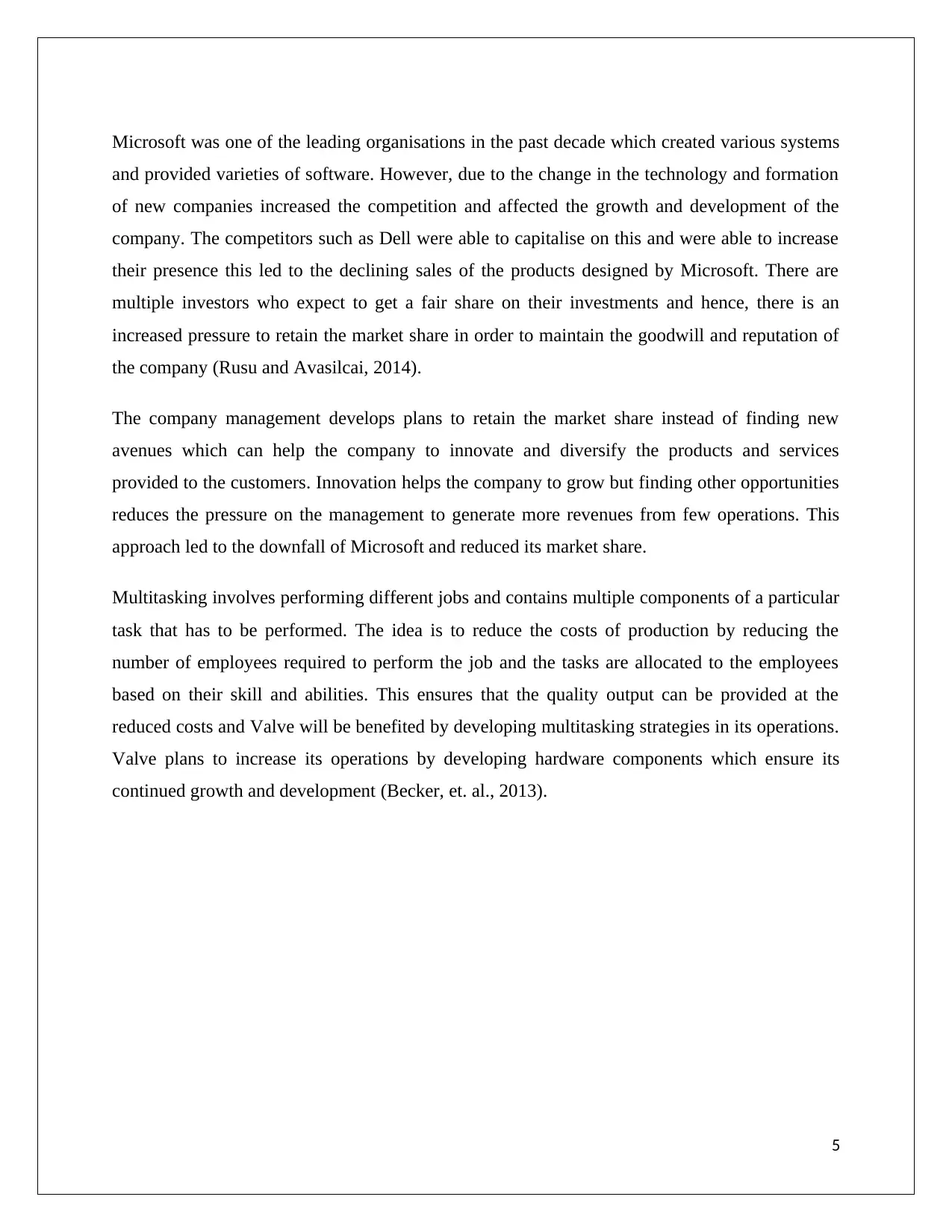
Microsoft was one of the leading organisations in the past decade which created various systems
and provided varieties of software. However, due to the change in the technology and formation
of new companies increased the competition and affected the growth and development of the
company. The competitors such as Dell were able to capitalise on this and were able to increase
their presence this led to the declining sales of the products designed by Microsoft. There are
multiple investors who expect to get a fair share on their investments and hence, there is an
increased pressure to retain the market share in order to maintain the goodwill and reputation of
the company (Rusu and Avasilcai, 2014).
The company management develops plans to retain the market share instead of finding new
avenues which can help the company to innovate and diversify the products and services
provided to the customers. Innovation helps the company to grow but finding other opportunities
reduces the pressure on the management to generate more revenues from few operations. This
approach led to the downfall of Microsoft and reduced its market share.
Multitasking involves performing different jobs and contains multiple components of a particular
task that has to be performed. The idea is to reduce the costs of production by reducing the
number of employees required to perform the job and the tasks are allocated to the employees
based on their skill and abilities. This ensures that the quality output can be provided at the
reduced costs and Valve will be benefited by developing multitasking strategies in its operations.
Valve plans to increase its operations by developing hardware components which ensure its
continued growth and development (Becker, et. al., 2013).
5
and provided varieties of software. However, due to the change in the technology and formation
of new companies increased the competition and affected the growth and development of the
company. The competitors such as Dell were able to capitalise on this and were able to increase
their presence this led to the declining sales of the products designed by Microsoft. There are
multiple investors who expect to get a fair share on their investments and hence, there is an
increased pressure to retain the market share in order to maintain the goodwill and reputation of
the company (Rusu and Avasilcai, 2014).
The company management develops plans to retain the market share instead of finding new
avenues which can help the company to innovate and diversify the products and services
provided to the customers. Innovation helps the company to grow but finding other opportunities
reduces the pressure on the management to generate more revenues from few operations. This
approach led to the downfall of Microsoft and reduced its market share.
Multitasking involves performing different jobs and contains multiple components of a particular
task that has to be performed. The idea is to reduce the costs of production by reducing the
number of employees required to perform the job and the tasks are allocated to the employees
based on their skill and abilities. This ensures that the quality output can be provided at the
reduced costs and Valve will be benefited by developing multitasking strategies in its operations.
Valve plans to increase its operations by developing hardware components which ensure its
continued growth and development (Becker, et. al., 2013).
5
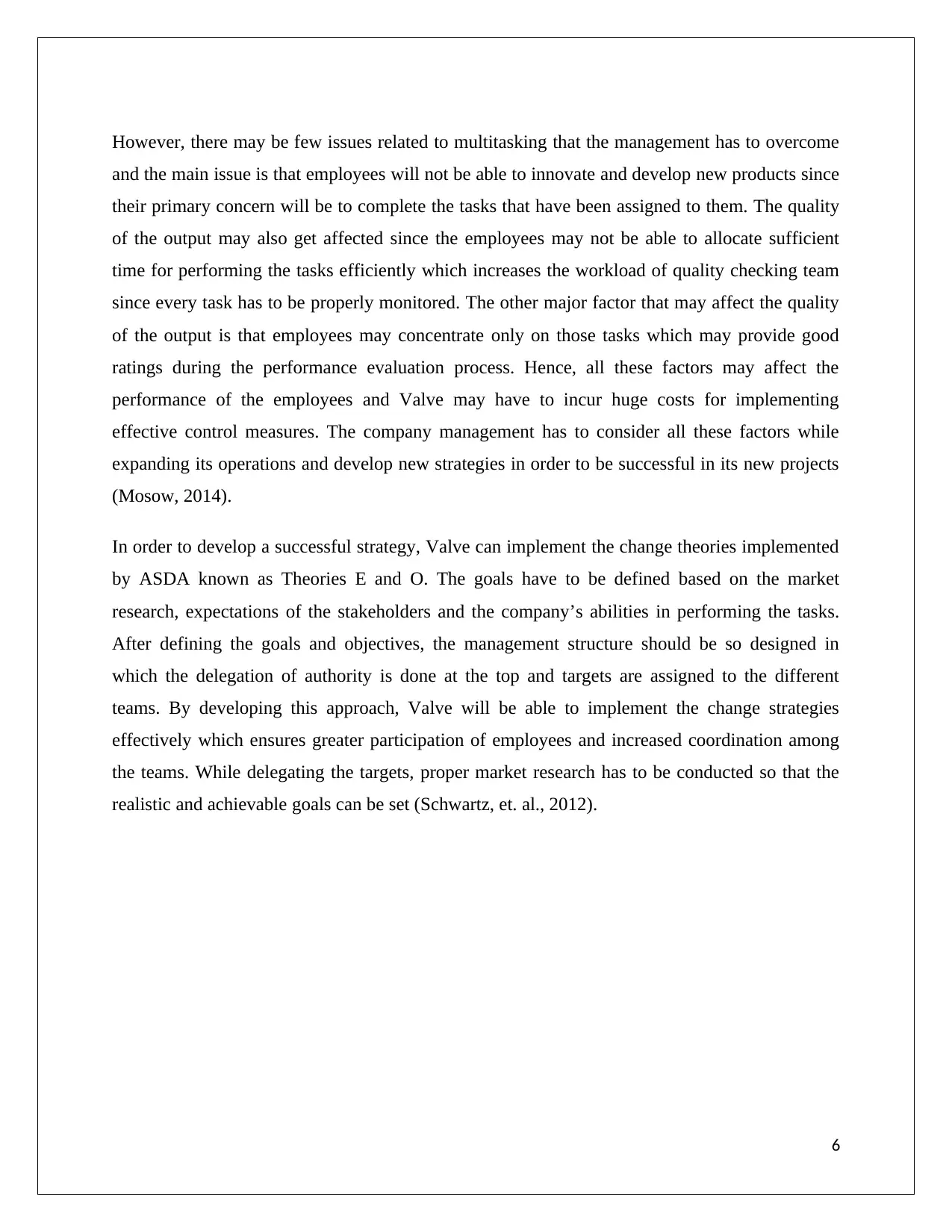
However, there may be few issues related to multitasking that the management has to overcome
and the main issue is that employees will not be able to innovate and develop new products since
their primary concern will be to complete the tasks that have been assigned to them. The quality
of the output may also get affected since the employees may not be able to allocate sufficient
time for performing the tasks efficiently which increases the workload of quality checking team
since every task has to be properly monitored. The other major factor that may affect the quality
of the output is that employees may concentrate only on those tasks which may provide good
ratings during the performance evaluation process. Hence, all these factors may affect the
performance of the employees and Valve may have to incur huge costs for implementing
effective control measures. The company management has to consider all these factors while
expanding its operations and develop new strategies in order to be successful in its new projects
(Mosow, 2014).
In order to develop a successful strategy, Valve can implement the change theories implemented
by ASDA known as Theories E and O. The goals have to be defined based on the market
research, expectations of the stakeholders and the company’s abilities in performing the tasks.
After defining the goals and objectives, the management structure should be so designed in
which the delegation of authority is done at the top and targets are assigned to the different
teams. By developing this approach, Valve will be able to implement the change strategies
effectively which ensures greater participation of employees and increased coordination among
the teams. While delegating the targets, proper market research has to be conducted so that the
realistic and achievable goals can be set (Schwartz, et. al., 2012).
6
and the main issue is that employees will not be able to innovate and develop new products since
their primary concern will be to complete the tasks that have been assigned to them. The quality
of the output may also get affected since the employees may not be able to allocate sufficient
time for performing the tasks efficiently which increases the workload of quality checking team
since every task has to be properly monitored. The other major factor that may affect the quality
of the output is that employees may concentrate only on those tasks which may provide good
ratings during the performance evaluation process. Hence, all these factors may affect the
performance of the employees and Valve may have to incur huge costs for implementing
effective control measures. The company management has to consider all these factors while
expanding its operations and develop new strategies in order to be successful in its new projects
(Mosow, 2014).
In order to develop a successful strategy, Valve can implement the change theories implemented
by ASDA known as Theories E and O. The goals have to be defined based on the market
research, expectations of the stakeholders and the company’s abilities in performing the tasks.
After defining the goals and objectives, the management structure should be so designed in
which the delegation of authority is done at the top and targets are assigned to the different
teams. By developing this approach, Valve will be able to implement the change strategies
effectively which ensures greater participation of employees and increased coordination among
the teams. While delegating the targets, proper market research has to be conducted so that the
realistic and achievable goals can be set (Schwartz, et. al., 2012).
6
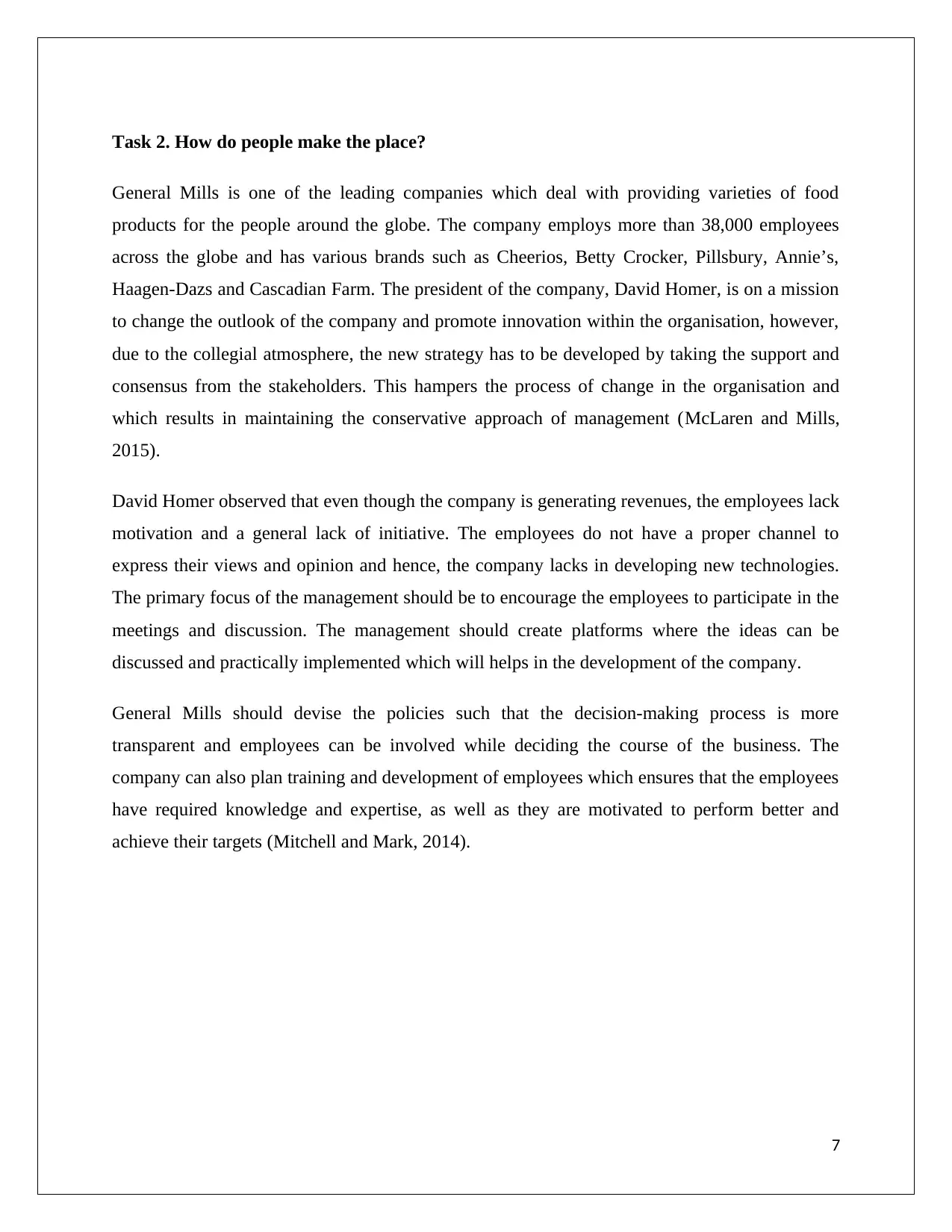
Task 2. How do people make the place?
General Mills is one of the leading companies which deal with providing varieties of food
products for the people around the globe. The company employs more than 38,000 employees
across the globe and has various brands such as Cheerios, Betty Crocker, Pillsbury, Annie’s,
Haagen-Dazs and Cascadian Farm. The president of the company, David Homer, is on a mission
to change the outlook of the company and promote innovation within the organisation, however,
due to the collegial atmosphere, the new strategy has to be developed by taking the support and
consensus from the stakeholders. This hampers the process of change in the organisation and
which results in maintaining the conservative approach of management (McLaren and Mills,
2015).
David Homer observed that even though the company is generating revenues, the employees lack
motivation and a general lack of initiative. The employees do not have a proper channel to
express their views and opinion and hence, the company lacks in developing new technologies.
The primary focus of the management should be to encourage the employees to participate in the
meetings and discussion. The management should create platforms where the ideas can be
discussed and practically implemented which will helps in the development of the company.
General Mills should devise the policies such that the decision-making process is more
transparent and employees can be involved while deciding the course of the business. The
company can also plan training and development of employees which ensures that the employees
have required knowledge and expertise, as well as they are motivated to perform better and
achieve their targets (Mitchell and Mark, 2014).
7
General Mills is one of the leading companies which deal with providing varieties of food
products for the people around the globe. The company employs more than 38,000 employees
across the globe and has various brands such as Cheerios, Betty Crocker, Pillsbury, Annie’s,
Haagen-Dazs and Cascadian Farm. The president of the company, David Homer, is on a mission
to change the outlook of the company and promote innovation within the organisation, however,
due to the collegial atmosphere, the new strategy has to be developed by taking the support and
consensus from the stakeholders. This hampers the process of change in the organisation and
which results in maintaining the conservative approach of management (McLaren and Mills,
2015).
David Homer observed that even though the company is generating revenues, the employees lack
motivation and a general lack of initiative. The employees do not have a proper channel to
express their views and opinion and hence, the company lacks in developing new technologies.
The primary focus of the management should be to encourage the employees to participate in the
meetings and discussion. The management should create platforms where the ideas can be
discussed and practically implemented which will helps in the development of the company.
General Mills should devise the policies such that the decision-making process is more
transparent and employees can be involved while deciding the course of the business. The
company can also plan training and development of employees which ensures that the employees
have required knowledge and expertise, as well as they are motivated to perform better and
achieve their targets (Mitchell and Mark, 2014).
7
Paraphrase This Document
Need a fresh take? Get an instant paraphrase of this document with our AI Paraphraser
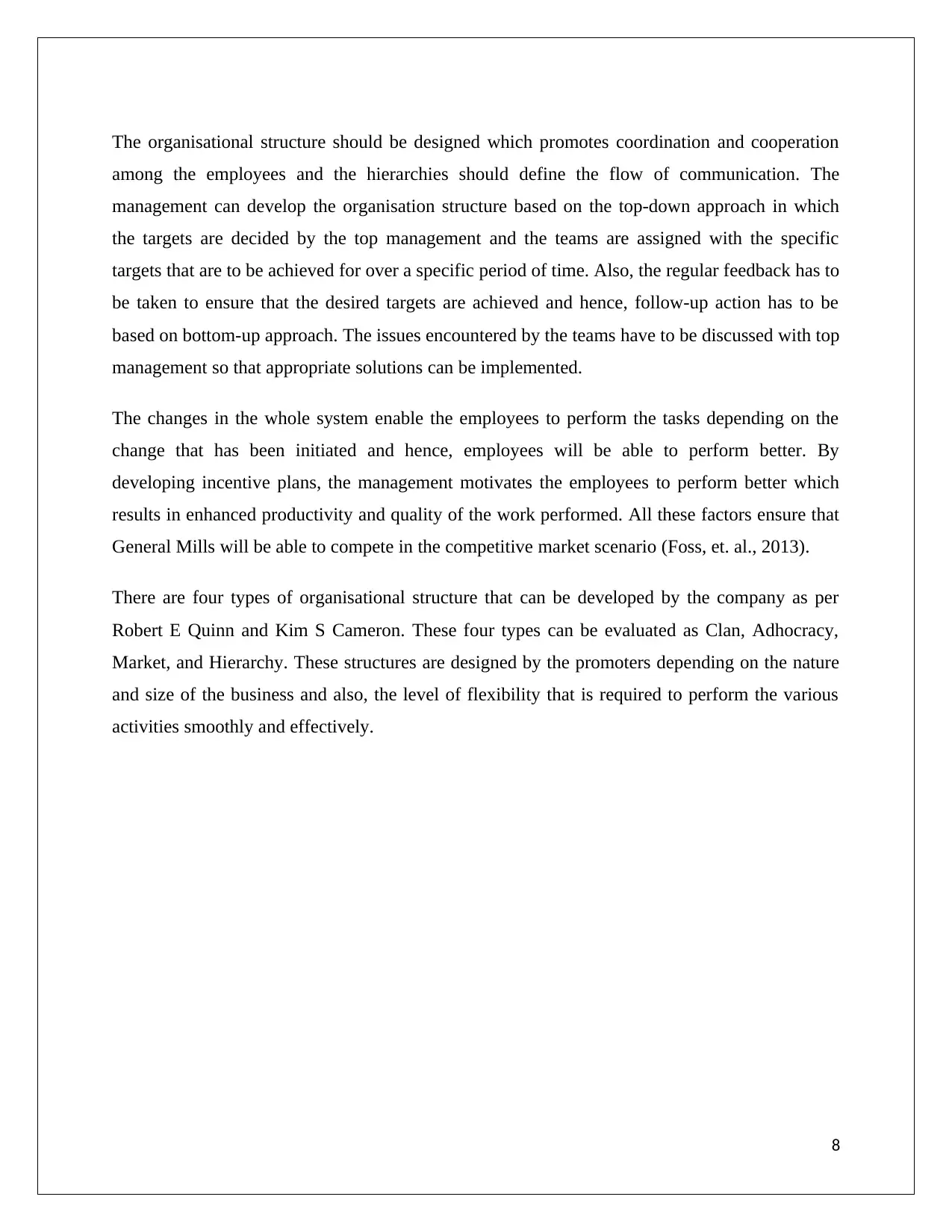
The organisational structure should be designed which promotes coordination and cooperation
among the employees and the hierarchies should define the flow of communication. The
management can develop the organisation structure based on the top-down approach in which
the targets are decided by the top management and the teams are assigned with the specific
targets that are to be achieved for over a specific period of time. Also, the regular feedback has to
be taken to ensure that the desired targets are achieved and hence, follow-up action has to be
based on bottom-up approach. The issues encountered by the teams have to be discussed with top
management so that appropriate solutions can be implemented.
The changes in the whole system enable the employees to perform the tasks depending on the
change that has been initiated and hence, employees will be able to perform better. By
developing incentive plans, the management motivates the employees to perform better which
results in enhanced productivity and quality of the work performed. All these factors ensure that
General Mills will be able to compete in the competitive market scenario (Foss, et. al., 2013).
There are four types of organisational structure that can be developed by the company as per
Robert E Quinn and Kim S Cameron. These four types can be evaluated as Clan, Adhocracy,
Market, and Hierarchy. These structures are designed by the promoters depending on the nature
and size of the business and also, the level of flexibility that is required to perform the various
activities smoothly and effectively.
8
among the employees and the hierarchies should define the flow of communication. The
management can develop the organisation structure based on the top-down approach in which
the targets are decided by the top management and the teams are assigned with the specific
targets that are to be achieved for over a specific period of time. Also, the regular feedback has to
be taken to ensure that the desired targets are achieved and hence, follow-up action has to be
based on bottom-up approach. The issues encountered by the teams have to be discussed with top
management so that appropriate solutions can be implemented.
The changes in the whole system enable the employees to perform the tasks depending on the
change that has been initiated and hence, employees will be able to perform better. By
developing incentive plans, the management motivates the employees to perform better which
results in enhanced productivity and quality of the work performed. All these factors ensure that
General Mills will be able to compete in the competitive market scenario (Foss, et. al., 2013).
There are four types of organisational structure that can be developed by the company as per
Robert E Quinn and Kim S Cameron. These four types can be evaluated as Clan, Adhocracy,
Market, and Hierarchy. These structures are designed by the promoters depending on the nature
and size of the business and also, the level of flexibility that is required to perform the various
activities smoothly and effectively.
8
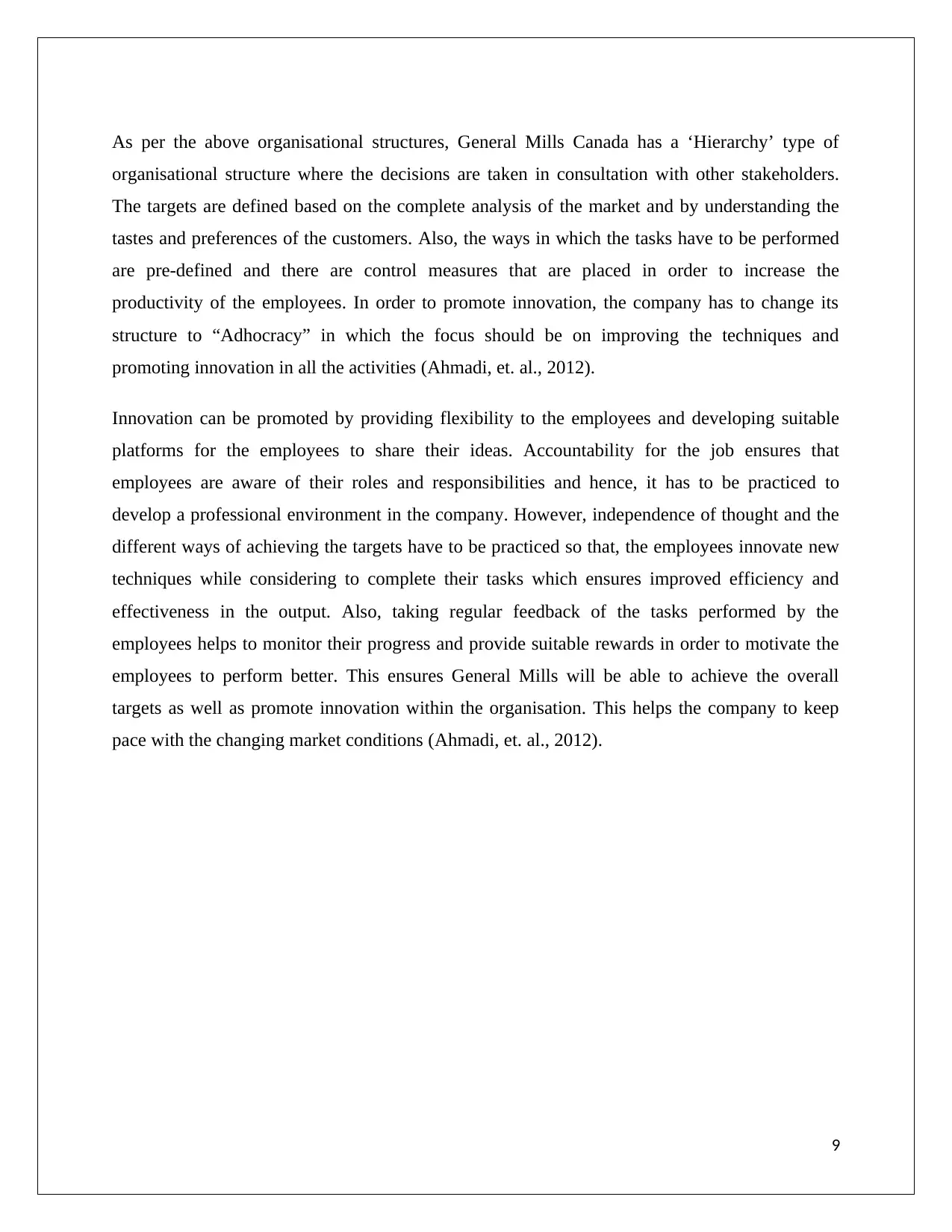
As per the above organisational structures, General Mills Canada has a ‘Hierarchy’ type of
organisational structure where the decisions are taken in consultation with other stakeholders.
The targets are defined based on the complete analysis of the market and by understanding the
tastes and preferences of the customers. Also, the ways in which the tasks have to be performed
are pre-defined and there are control measures that are placed in order to increase the
productivity of the employees. In order to promote innovation, the company has to change its
structure to “Adhocracy” in which the focus should be on improving the techniques and
promoting innovation in all the activities (Ahmadi, et. al., 2012).
Innovation can be promoted by providing flexibility to the employees and developing suitable
platforms for the employees to share their ideas. Accountability for the job ensures that
employees are aware of their roles and responsibilities and hence, it has to be practiced to
develop a professional environment in the company. However, independence of thought and the
different ways of achieving the targets have to be practiced so that, the employees innovate new
techniques while considering to complete their tasks which ensures improved efficiency and
effectiveness in the output. Also, taking regular feedback of the tasks performed by the
employees helps to monitor their progress and provide suitable rewards in order to motivate the
employees to perform better. This ensures General Mills will be able to achieve the overall
targets as well as promote innovation within the organisation. This helps the company to keep
pace with the changing market conditions (Ahmadi, et. al., 2012).
9
organisational structure where the decisions are taken in consultation with other stakeholders.
The targets are defined based on the complete analysis of the market and by understanding the
tastes and preferences of the customers. Also, the ways in which the tasks have to be performed
are pre-defined and there are control measures that are placed in order to increase the
productivity of the employees. In order to promote innovation, the company has to change its
structure to “Adhocracy” in which the focus should be on improving the techniques and
promoting innovation in all the activities (Ahmadi, et. al., 2012).
Innovation can be promoted by providing flexibility to the employees and developing suitable
platforms for the employees to share their ideas. Accountability for the job ensures that
employees are aware of their roles and responsibilities and hence, it has to be practiced to
develop a professional environment in the company. However, independence of thought and the
different ways of achieving the targets have to be practiced so that, the employees innovate new
techniques while considering to complete their tasks which ensures improved efficiency and
effectiveness in the output. Also, taking regular feedback of the tasks performed by the
employees helps to monitor their progress and provide suitable rewards in order to motivate the
employees to perform better. This ensures General Mills will be able to achieve the overall
targets as well as promote innovation within the organisation. This helps the company to keep
pace with the changing market conditions (Ahmadi, et. al., 2012).
9
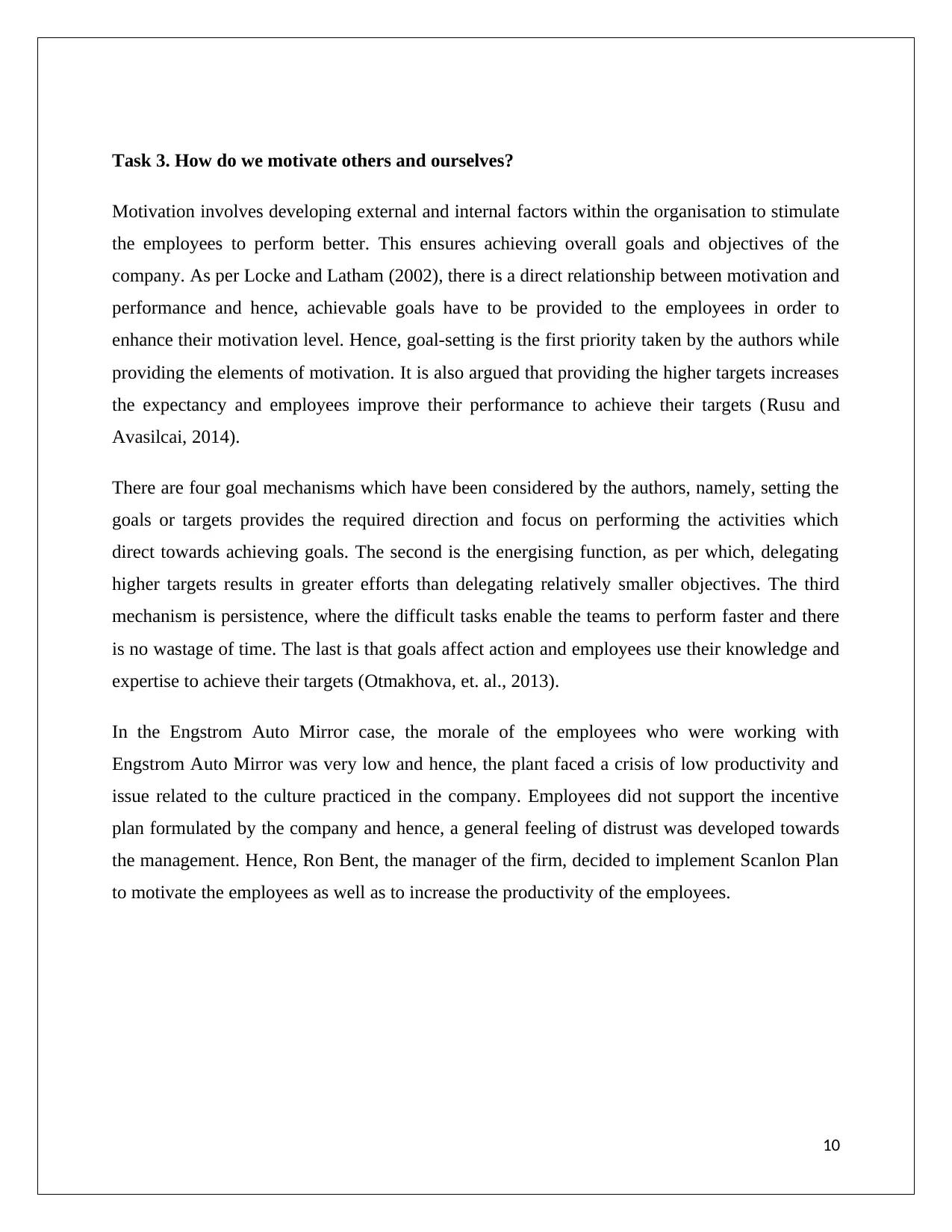
Task 3. How do we motivate others and ourselves?
Motivation involves developing external and internal factors within the organisation to stimulate
the employees to perform better. This ensures achieving overall goals and objectives of the
company. As per Locke and Latham (2002), there is a direct relationship between motivation and
performance and hence, achievable goals have to be provided to the employees in order to
enhance their motivation level. Hence, goal-setting is the first priority taken by the authors while
providing the elements of motivation. It is also argued that providing the higher targets increases
the expectancy and employees improve their performance to achieve their targets (Rusu and
Avasilcai, 2014).
There are four goal mechanisms which have been considered by the authors, namely, setting the
goals or targets provides the required direction and focus on performing the activities which
direct towards achieving goals. The second is the energising function, as per which, delegating
higher targets results in greater efforts than delegating relatively smaller objectives. The third
mechanism is persistence, where the difficult tasks enable the teams to perform faster and there
is no wastage of time. The last is that goals affect action and employees use their knowledge and
expertise to achieve their targets (Otmakhova, et. al., 2013).
In the Engstrom Auto Mirror case, the morale of the employees who were working with
Engstrom Auto Mirror was very low and hence, the plant faced a crisis of low productivity and
issue related to the culture practiced in the company. Employees did not support the incentive
plan formulated by the company and hence, a general feeling of distrust was developed towards
the management. Hence, Ron Bent, the manager of the firm, decided to implement Scanlon Plan
to motivate the employees as well as to increase the productivity of the employees.
10
Motivation involves developing external and internal factors within the organisation to stimulate
the employees to perform better. This ensures achieving overall goals and objectives of the
company. As per Locke and Latham (2002), there is a direct relationship between motivation and
performance and hence, achievable goals have to be provided to the employees in order to
enhance their motivation level. Hence, goal-setting is the first priority taken by the authors while
providing the elements of motivation. It is also argued that providing the higher targets increases
the expectancy and employees improve their performance to achieve their targets (Rusu and
Avasilcai, 2014).
There are four goal mechanisms which have been considered by the authors, namely, setting the
goals or targets provides the required direction and focus on performing the activities which
direct towards achieving goals. The second is the energising function, as per which, delegating
higher targets results in greater efforts than delegating relatively smaller objectives. The third
mechanism is persistence, where the difficult tasks enable the teams to perform faster and there
is no wastage of time. The last is that goals affect action and employees use their knowledge and
expertise to achieve their targets (Otmakhova, et. al., 2013).
In the Engstrom Auto Mirror case, the morale of the employees who were working with
Engstrom Auto Mirror was very low and hence, the plant faced a crisis of low productivity and
issue related to the culture practiced in the company. Employees did not support the incentive
plan formulated by the company and hence, a general feeling of distrust was developed towards
the management. Hence, Ron Bent, the manager of the firm, decided to implement Scanlon Plan
to motivate the employees as well as to increase the productivity of the employees.
10
Secure Best Marks with AI Grader
Need help grading? Try our AI Grader for instant feedback on your assignments.
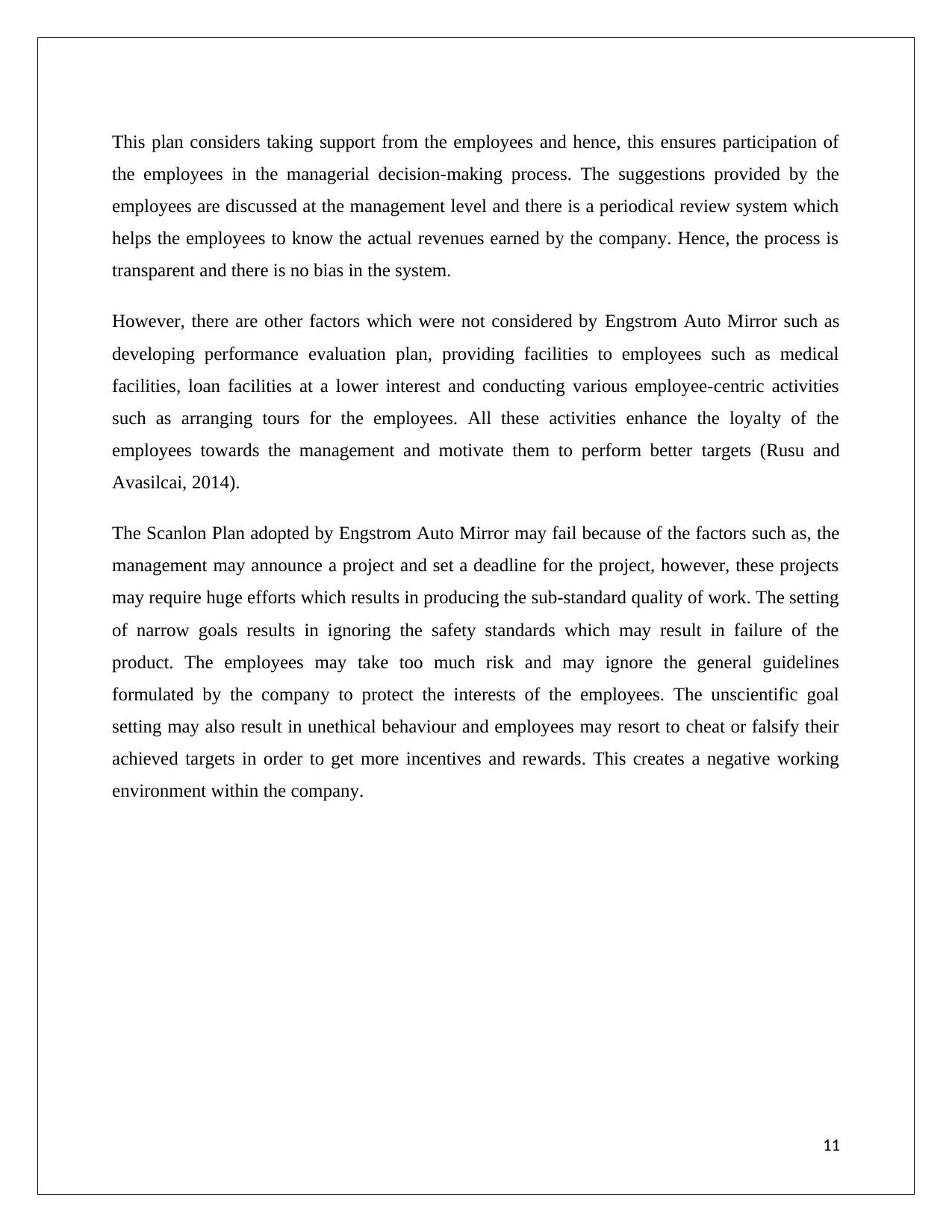
This plan considers taking support from the employees and hence, this ensures participation of
the employees in the managerial decision-making process. The suggestions provided by the
employees are discussed at the management level and there is a periodical review system which
helps the employees to know the actual revenues earned by the company. Hence, the process is
transparent and there is no bias in the system.
However, there are other factors which were not considered by Engstrom Auto Mirror such as
developing performance evaluation plan, providing facilities to employees such as medical
facilities, loan facilities at a lower interest and conducting various employee-centric activities
such as arranging tours for the employees. All these activities enhance the loyalty of the
employees towards the management and motivate them to perform better targets (Rusu and
Avasilcai, 2014).
The Scanlon Plan adopted by Engstrom Auto Mirror may fail because of the factors such as, the
management may announce a project and set a deadline for the project, however, these projects
may require huge efforts which results in producing the sub-standard quality of work. The setting
of narrow goals results in ignoring the safety standards which may result in failure of the
product. The employees may take too much risk and may ignore the general guidelines
formulated by the company to protect the interests of the employees. The unscientific goal
setting may also result in unethical behaviour and employees may resort to cheat or falsify their
achieved targets in order to get more incentives and rewards. This creates a negative working
environment within the company.
11
the employees in the managerial decision-making process. The suggestions provided by the
employees are discussed at the management level and there is a periodical review system which
helps the employees to know the actual revenues earned by the company. Hence, the process is
transparent and there is no bias in the system.
However, there are other factors which were not considered by Engstrom Auto Mirror such as
developing performance evaluation plan, providing facilities to employees such as medical
facilities, loan facilities at a lower interest and conducting various employee-centric activities
such as arranging tours for the employees. All these activities enhance the loyalty of the
employees towards the management and motivate them to perform better targets (Rusu and
Avasilcai, 2014).
The Scanlon Plan adopted by Engstrom Auto Mirror may fail because of the factors such as, the
management may announce a project and set a deadline for the project, however, these projects
may require huge efforts which results in producing the sub-standard quality of work. The setting
of narrow goals results in ignoring the safety standards which may result in failure of the
product. The employees may take too much risk and may ignore the general guidelines
formulated by the company to protect the interests of the employees. The unscientific goal
setting may also result in unethical behaviour and employees may resort to cheat or falsify their
achieved targets in order to get more incentives and rewards. This creates a negative working
environment within the company.
11
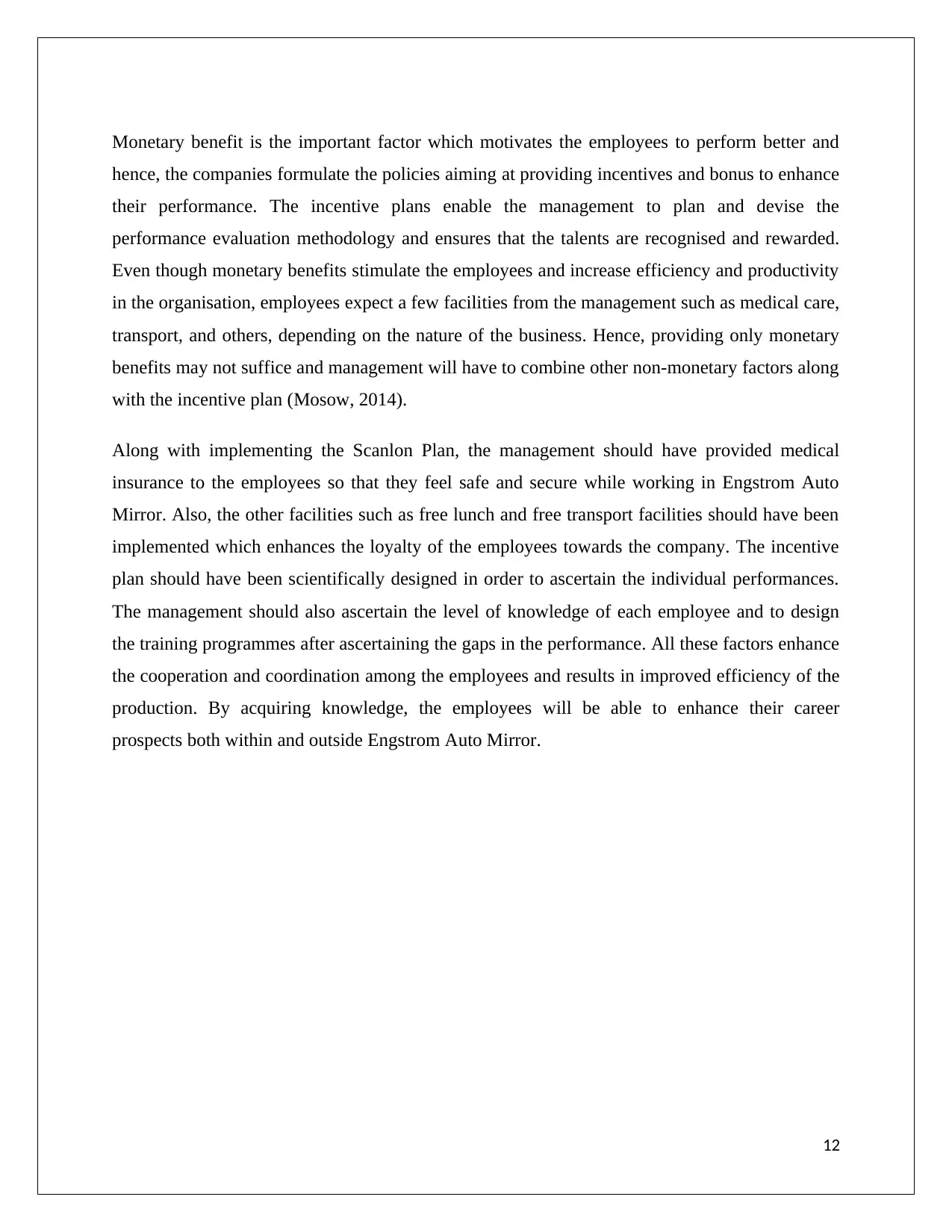
Monetary benefit is the important factor which motivates the employees to perform better and
hence, the companies formulate the policies aiming at providing incentives and bonus to enhance
their performance. The incentive plans enable the management to plan and devise the
performance evaluation methodology and ensures that the talents are recognised and rewarded.
Even though monetary benefits stimulate the employees and increase efficiency and productivity
in the organisation, employees expect a few facilities from the management such as medical care,
transport, and others, depending on the nature of the business. Hence, providing only monetary
benefits may not suffice and management will have to combine other non-monetary factors along
with the incentive plan (Mosow, 2014).
Along with implementing the Scanlon Plan, the management should have provided medical
insurance to the employees so that they feel safe and secure while working in Engstrom Auto
Mirror. Also, the other facilities such as free lunch and free transport facilities should have been
implemented which enhances the loyalty of the employees towards the company. The incentive
plan should have been scientifically designed in order to ascertain the individual performances.
The management should also ascertain the level of knowledge of each employee and to design
the training programmes after ascertaining the gaps in the performance. All these factors enhance
the cooperation and coordination among the employees and results in improved efficiency of the
production. By acquiring knowledge, the employees will be able to enhance their career
prospects both within and outside Engstrom Auto Mirror.
12
hence, the companies formulate the policies aiming at providing incentives and bonus to enhance
their performance. The incentive plans enable the management to plan and devise the
performance evaluation methodology and ensures that the talents are recognised and rewarded.
Even though monetary benefits stimulate the employees and increase efficiency and productivity
in the organisation, employees expect a few facilities from the management such as medical care,
transport, and others, depending on the nature of the business. Hence, providing only monetary
benefits may not suffice and management will have to combine other non-monetary factors along
with the incentive plan (Mosow, 2014).
Along with implementing the Scanlon Plan, the management should have provided medical
insurance to the employees so that they feel safe and secure while working in Engstrom Auto
Mirror. Also, the other facilities such as free lunch and free transport facilities should have been
implemented which enhances the loyalty of the employees towards the company. The incentive
plan should have been scientifically designed in order to ascertain the individual performances.
The management should also ascertain the level of knowledge of each employee and to design
the training programmes after ascertaining the gaps in the performance. All these factors enhance
the cooperation and coordination among the employees and results in improved efficiency of the
production. By acquiring knowledge, the employees will be able to enhance their career
prospects both within and outside Engstrom Auto Mirror.
12
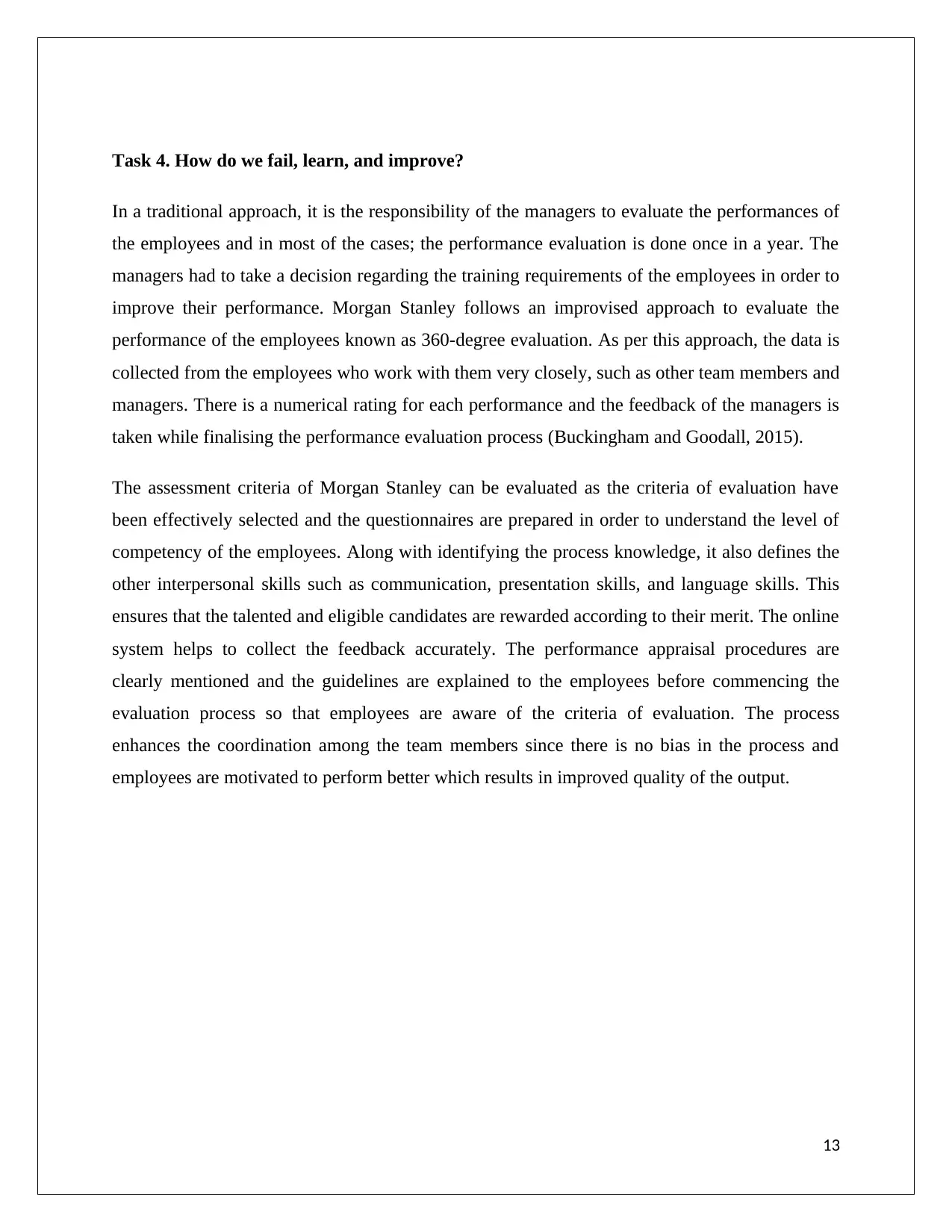
Task 4. How do we fail, learn, and improve?
In a traditional approach, it is the responsibility of the managers to evaluate the performances of
the employees and in most of the cases; the performance evaluation is done once in a year. The
managers had to take a decision regarding the training requirements of the employees in order to
improve their performance. Morgan Stanley follows an improvised approach to evaluate the
performance of the employees known as 360-degree evaluation. As per this approach, the data is
collected from the employees who work with them very closely, such as other team members and
managers. There is a numerical rating for each performance and the feedback of the managers is
taken while finalising the performance evaluation process (Buckingham and Goodall, 2015).
The assessment criteria of Morgan Stanley can be evaluated as the criteria of evaluation have
been effectively selected and the questionnaires are prepared in order to understand the level of
competency of the employees. Along with identifying the process knowledge, it also defines the
other interpersonal skills such as communication, presentation skills, and language skills. This
ensures that the talented and eligible candidates are rewarded according to their merit. The online
system helps to collect the feedback accurately. The performance appraisal procedures are
clearly mentioned and the guidelines are explained to the employees before commencing the
evaluation process so that employees are aware of the criteria of evaluation. The process
enhances the coordination among the team members since there is no bias in the process and
employees are motivated to perform better which results in improved quality of the output.
13
In a traditional approach, it is the responsibility of the managers to evaluate the performances of
the employees and in most of the cases; the performance evaluation is done once in a year. The
managers had to take a decision regarding the training requirements of the employees in order to
improve their performance. Morgan Stanley follows an improvised approach to evaluate the
performance of the employees known as 360-degree evaluation. As per this approach, the data is
collected from the employees who work with them very closely, such as other team members and
managers. There is a numerical rating for each performance and the feedback of the managers is
taken while finalising the performance evaluation process (Buckingham and Goodall, 2015).
The assessment criteria of Morgan Stanley can be evaluated as the criteria of evaluation have
been effectively selected and the questionnaires are prepared in order to understand the level of
competency of the employees. Along with identifying the process knowledge, it also defines the
other interpersonal skills such as communication, presentation skills, and language skills. This
ensures that the talented and eligible candidates are rewarded according to their merit. The online
system helps to collect the feedback accurately. The performance appraisal procedures are
clearly mentioned and the guidelines are explained to the employees before commencing the
evaluation process so that employees are aware of the criteria of evaluation. The process
enhances the coordination among the team members since there is no bias in the process and
employees are motivated to perform better which results in improved quality of the output.
13
Paraphrase This Document
Need a fresh take? Get an instant paraphrase of this document with our AI Paraphraser
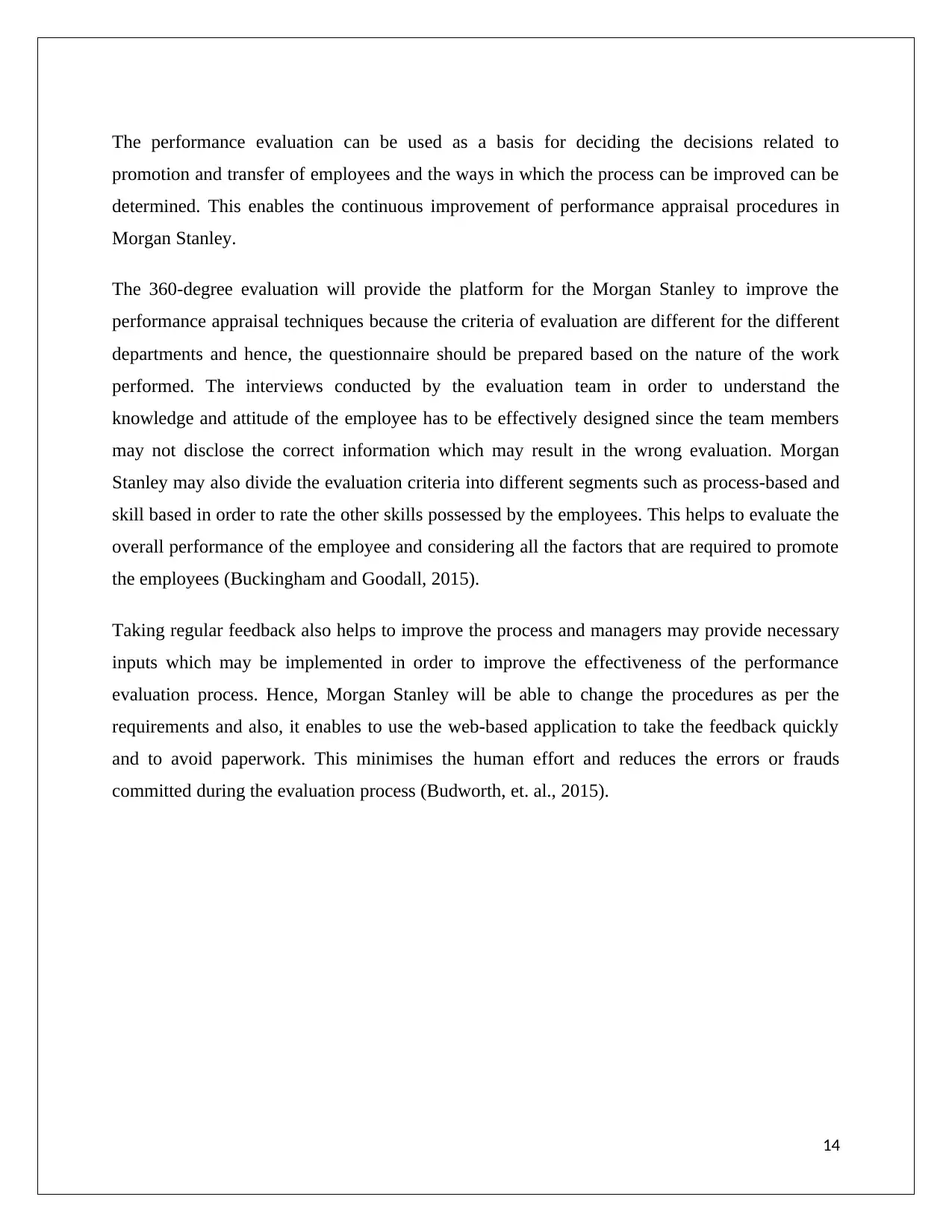
The performance evaluation can be used as a basis for deciding the decisions related to
promotion and transfer of employees and the ways in which the process can be improved can be
determined. This enables the continuous improvement of performance appraisal procedures in
Morgan Stanley.
The 360-degree evaluation will provide the platform for the Morgan Stanley to improve the
performance appraisal techniques because the criteria of evaluation are different for the different
departments and hence, the questionnaire should be prepared based on the nature of the work
performed. The interviews conducted by the evaluation team in order to understand the
knowledge and attitude of the employee has to be effectively designed since the team members
may not disclose the correct information which may result in the wrong evaluation. Morgan
Stanley may also divide the evaluation criteria into different segments such as process-based and
skill based in order to rate the other skills possessed by the employees. This helps to evaluate the
overall performance of the employee and considering all the factors that are required to promote
the employees (Buckingham and Goodall, 2015).
Taking regular feedback also helps to improve the process and managers may provide necessary
inputs which may be implemented in order to improve the effectiveness of the performance
evaluation process. Hence, Morgan Stanley will be able to change the procedures as per the
requirements and also, it enables to use the web-based application to take the feedback quickly
and to avoid paperwork. This minimises the human effort and reduces the errors or frauds
committed during the evaluation process (Budworth, et. al., 2015).
14
promotion and transfer of employees and the ways in which the process can be improved can be
determined. This enables the continuous improvement of performance appraisal procedures in
Morgan Stanley.
The 360-degree evaluation will provide the platform for the Morgan Stanley to improve the
performance appraisal techniques because the criteria of evaluation are different for the different
departments and hence, the questionnaire should be prepared based on the nature of the work
performed. The interviews conducted by the evaluation team in order to understand the
knowledge and attitude of the employee has to be effectively designed since the team members
may not disclose the correct information which may result in the wrong evaluation. Morgan
Stanley may also divide the evaluation criteria into different segments such as process-based and
skill based in order to rate the other skills possessed by the employees. This helps to evaluate the
overall performance of the employee and considering all the factors that are required to promote
the employees (Buckingham and Goodall, 2015).
Taking regular feedback also helps to improve the process and managers may provide necessary
inputs which may be implemented in order to improve the effectiveness of the performance
evaluation process. Hence, Morgan Stanley will be able to change the procedures as per the
requirements and also, it enables to use the web-based application to take the feedback quickly
and to avoid paperwork. This minimises the human effort and reduces the errors or frauds
committed during the evaluation process (Budworth, et. al., 2015).
14
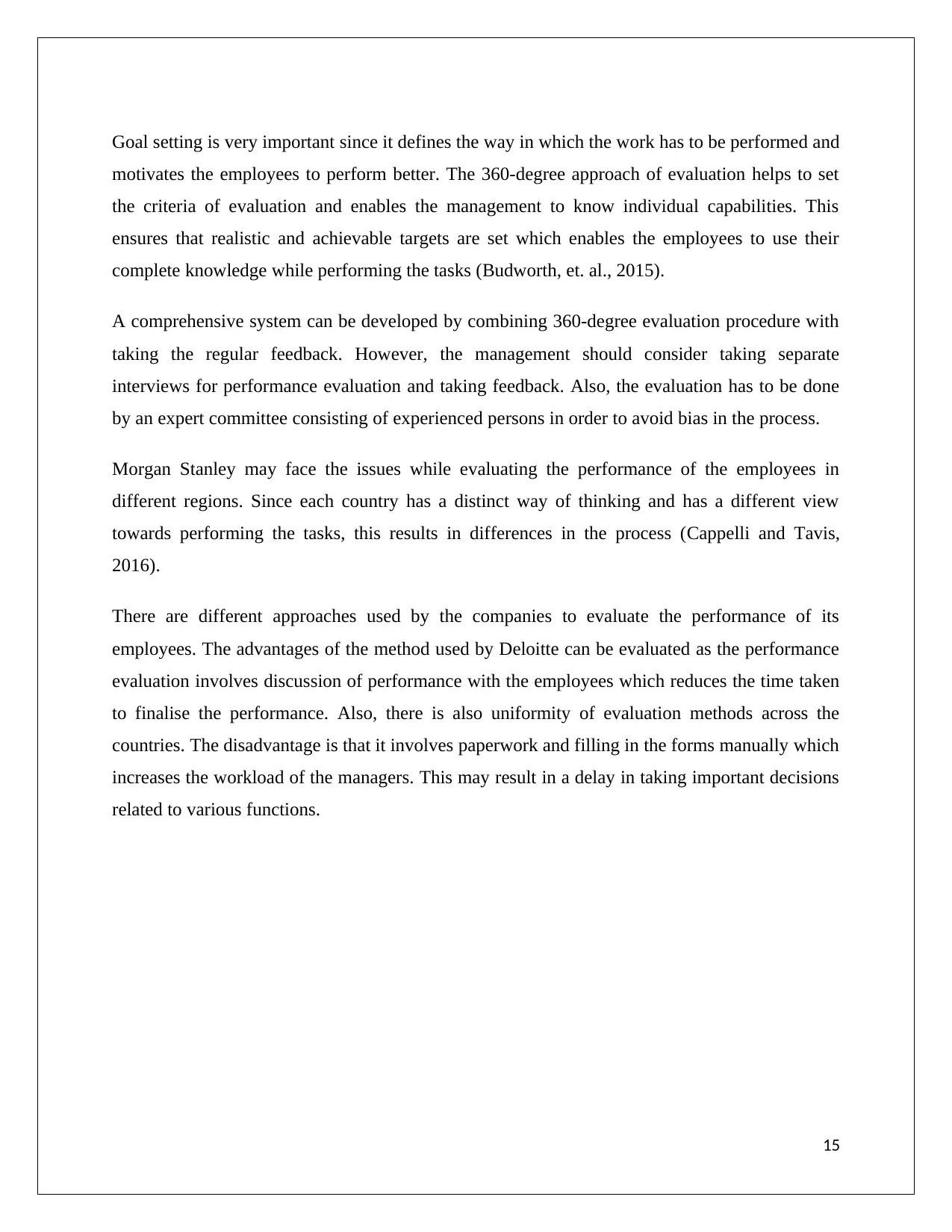
Goal setting is very important since it defines the way in which the work has to be performed and
motivates the employees to perform better. The 360-degree approach of evaluation helps to set
the criteria of evaluation and enables the management to know individual capabilities. This
ensures that realistic and achievable targets are set which enables the employees to use their
complete knowledge while performing the tasks (Budworth, et. al., 2015).
A comprehensive system can be developed by combining 360-degree evaluation procedure with
taking the regular feedback. However, the management should consider taking separate
interviews for performance evaluation and taking feedback. Also, the evaluation has to be done
by an expert committee consisting of experienced persons in order to avoid bias in the process.
Morgan Stanley may face the issues while evaluating the performance of the employees in
different regions. Since each country has a distinct way of thinking and has a different view
towards performing the tasks, this results in differences in the process (Cappelli and Tavis,
2016).
There are different approaches used by the companies to evaluate the performance of its
employees. The advantages of the method used by Deloitte can be evaluated as the performance
evaluation involves discussion of performance with the employees which reduces the time taken
to finalise the performance. Also, there is also uniformity of evaluation methods across the
countries. The disadvantage is that it involves paperwork and filling in the forms manually which
increases the workload of the managers. This may result in a delay in taking important decisions
related to various functions.
15
motivates the employees to perform better. The 360-degree approach of evaluation helps to set
the criteria of evaluation and enables the management to know individual capabilities. This
ensures that realistic and achievable targets are set which enables the employees to use their
complete knowledge while performing the tasks (Budworth, et. al., 2015).
A comprehensive system can be developed by combining 360-degree evaluation procedure with
taking the regular feedback. However, the management should consider taking separate
interviews for performance evaluation and taking feedback. Also, the evaluation has to be done
by an expert committee consisting of experienced persons in order to avoid bias in the process.
Morgan Stanley may face the issues while evaluating the performance of the employees in
different regions. Since each country has a distinct way of thinking and has a different view
towards performing the tasks, this results in differences in the process (Cappelli and Tavis,
2016).
There are different approaches used by the companies to evaluate the performance of its
employees. The advantages of the method used by Deloitte can be evaluated as the performance
evaluation involves discussion of performance with the employees which reduces the time taken
to finalise the performance. Also, there is also uniformity of evaluation methods across the
countries. The disadvantage is that it involves paperwork and filling in the forms manually which
increases the workload of the managers. This may result in a delay in taking important decisions
related to various functions.
15
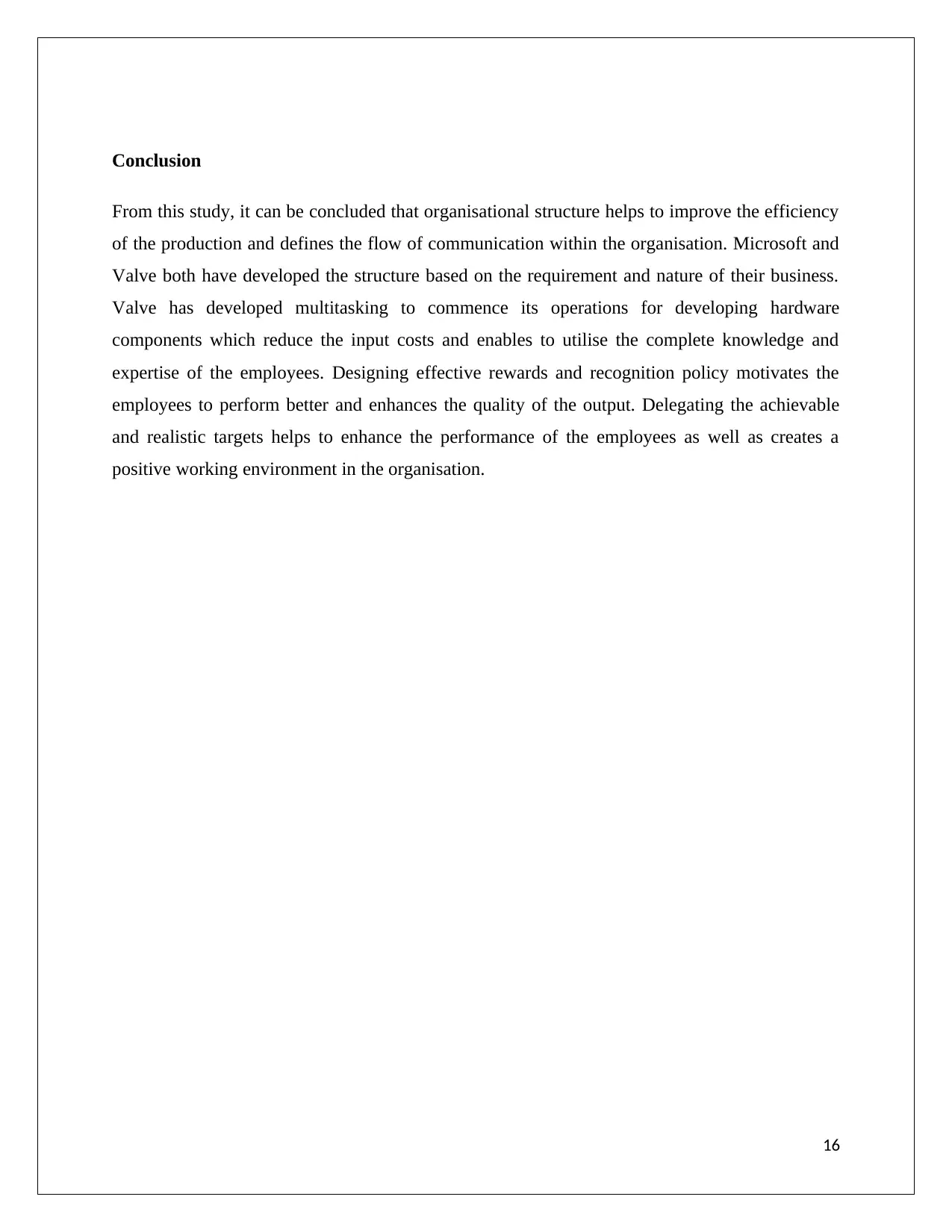
Conclusion
From this study, it can be concluded that organisational structure helps to improve the efficiency
of the production and defines the flow of communication within the organisation. Microsoft and
Valve both have developed the structure based on the requirement and nature of their business.
Valve has developed multitasking to commence its operations for developing hardware
components which reduce the input costs and enables to utilise the complete knowledge and
expertise of the employees. Designing effective rewards and recognition policy motivates the
employees to perform better and enhances the quality of the output. Delegating the achievable
and realistic targets helps to enhance the performance of the employees as well as creates a
positive working environment in the organisation.
16
From this study, it can be concluded that organisational structure helps to improve the efficiency
of the production and defines the flow of communication within the organisation. Microsoft and
Valve both have developed the structure based on the requirement and nature of their business.
Valve has developed multitasking to commence its operations for developing hardware
components which reduce the input costs and enables to utilise the complete knowledge and
expertise of the employees. Designing effective rewards and recognition policy motivates the
employees to perform better and enhances the quality of the output. Delegating the achievable
and realistic targets helps to enhance the performance of the employees as well as creates a
positive working environment in the organisation.
16
Secure Best Marks with AI Grader
Need help grading? Try our AI Grader for instant feedback on your assignments.
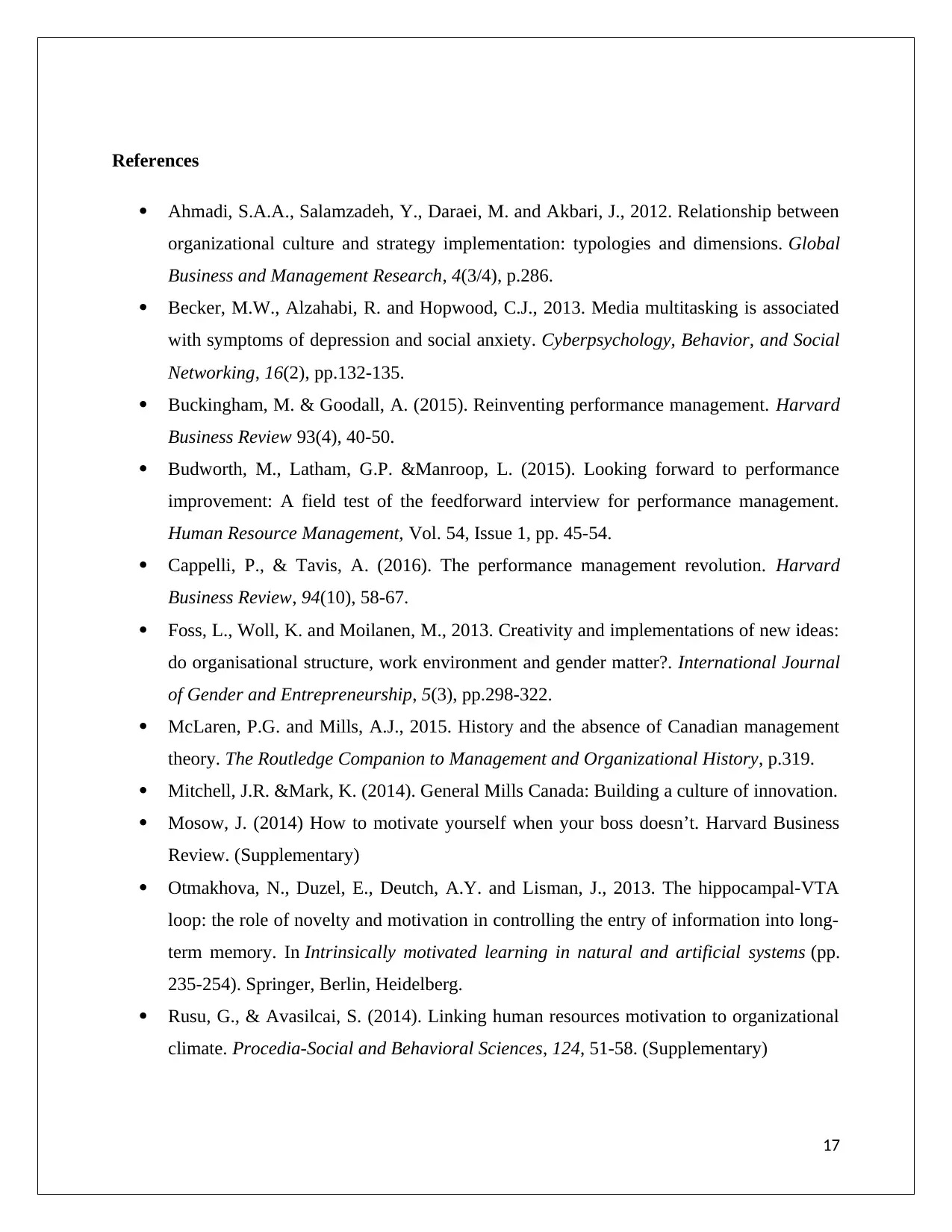
References
Ahmadi, S.A.A., Salamzadeh, Y., Daraei, M. and Akbari, J., 2012. Relationship between
organizational culture and strategy implementation: typologies and dimensions. Global
Business and Management Research, 4(3/4), p.286.
Becker, M.W., Alzahabi, R. and Hopwood, C.J., 2013. Media multitasking is associated
with symptoms of depression and social anxiety. Cyberpsychology, Behavior, and Social
Networking, 16(2), pp.132-135.
Buckingham, M. & Goodall, A. (2015). Reinventing performance management. Harvard
Business Review 93(4), 40-50.
Budworth, M., Latham, G.P. &Manroop, L. (2015). Looking forward to performance
improvement: A field test of the feedforward interview for performance management.
Human Resource Management, Vol. 54, Issue 1, pp. 45-54.
Cappelli, P., & Tavis, A. (2016). The performance management revolution. Harvard
Business Review, 94(10), 58-67.
Foss, L., Woll, K. and Moilanen, M., 2013. Creativity and implementations of new ideas:
do organisational structure, work environment and gender matter?. International Journal
of Gender and Entrepreneurship, 5(3), pp.298-322.
McLaren, P.G. and Mills, A.J., 2015. History and the absence of Canadian management
theory. The Routledge Companion to Management and Organizational History, p.319.
Mitchell, J.R. &Mark, K. (2014). General Mills Canada: Building a culture of innovation.
Mosow, J. (2014) How to motivate yourself when your boss doesn’t. Harvard Business
Review. (Supplementary)
Otmakhova, N., Duzel, E., Deutch, A.Y. and Lisman, J., 2013. The hippocampal-VTA
loop: the role of novelty and motivation in controlling the entry of information into long-
term memory. In Intrinsically motivated learning in natural and artificial systems (pp.
235-254). Springer, Berlin, Heidelberg.
Rusu, G., & Avasilcai, S. (2014). Linking human resources motivation to organizational
climate. Procedia-Social and Behavioral Sciences, 124, 51-58. (Supplementary)
17
Ahmadi, S.A.A., Salamzadeh, Y., Daraei, M. and Akbari, J., 2012. Relationship between
organizational culture and strategy implementation: typologies and dimensions. Global
Business and Management Research, 4(3/4), p.286.
Becker, M.W., Alzahabi, R. and Hopwood, C.J., 2013. Media multitasking is associated
with symptoms of depression and social anxiety. Cyberpsychology, Behavior, and Social
Networking, 16(2), pp.132-135.
Buckingham, M. & Goodall, A. (2015). Reinventing performance management. Harvard
Business Review 93(4), 40-50.
Budworth, M., Latham, G.P. &Manroop, L. (2015). Looking forward to performance
improvement: A field test of the feedforward interview for performance management.
Human Resource Management, Vol. 54, Issue 1, pp. 45-54.
Cappelli, P., & Tavis, A. (2016). The performance management revolution. Harvard
Business Review, 94(10), 58-67.
Foss, L., Woll, K. and Moilanen, M., 2013. Creativity and implementations of new ideas:
do organisational structure, work environment and gender matter?. International Journal
of Gender and Entrepreneurship, 5(3), pp.298-322.
McLaren, P.G. and Mills, A.J., 2015. History and the absence of Canadian management
theory. The Routledge Companion to Management and Organizational History, p.319.
Mitchell, J.R. &Mark, K. (2014). General Mills Canada: Building a culture of innovation.
Mosow, J. (2014) How to motivate yourself when your boss doesn’t. Harvard Business
Review. (Supplementary)
Otmakhova, N., Duzel, E., Deutch, A.Y. and Lisman, J., 2013. The hippocampal-VTA
loop: the role of novelty and motivation in controlling the entry of information into long-
term memory. In Intrinsically motivated learning in natural and artificial systems (pp.
235-254). Springer, Berlin, Heidelberg.
Rusu, G., & Avasilcai, S. (2014). Linking human resources motivation to organizational
climate. Procedia-Social and Behavioral Sciences, 124, 51-58. (Supplementary)
17
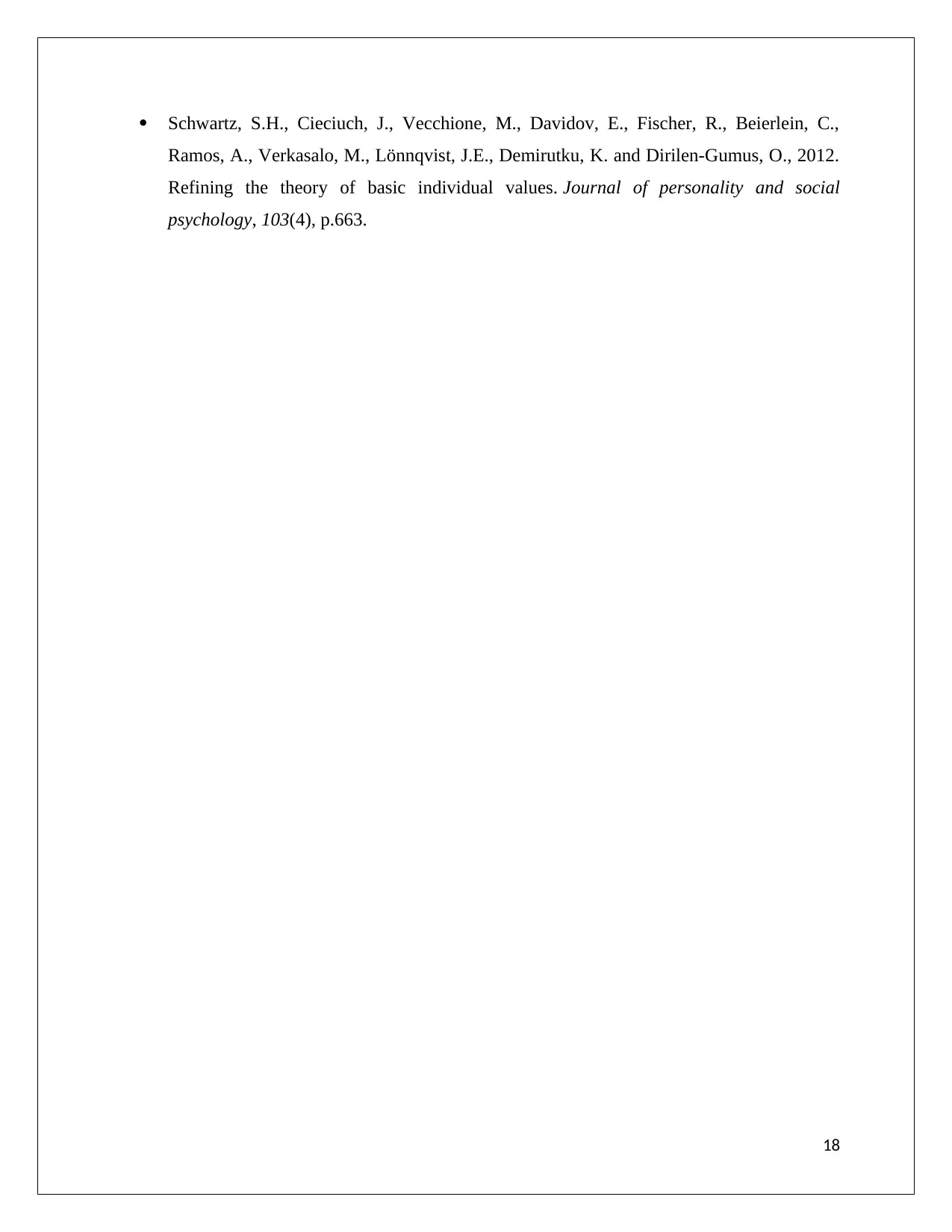
Schwartz, S.H., Cieciuch, J., Vecchione, M., Davidov, E., Fischer, R., Beierlein, C.,
Ramos, A., Verkasalo, M., Lönnqvist, J.E., Demirutku, K. and Dirilen-Gumus, O., 2012.
Refining the theory of basic individual values. Journal of personality and social
psychology, 103(4), p.663.
18
Ramos, A., Verkasalo, M., Lönnqvist, J.E., Demirutku, K. and Dirilen-Gumus, O., 2012.
Refining the theory of basic individual values. Journal of personality and social
psychology, 103(4), p.663.
18
1 out of 18
Related Documents
Your All-in-One AI-Powered Toolkit for Academic Success.
+13062052269
info@desklib.com
Available 24*7 on WhatsApp / Email
![[object Object]](/_next/static/media/star-bottom.7253800d.svg)
Unlock your academic potential
© 2024 | Zucol Services PVT LTD | All rights reserved.





